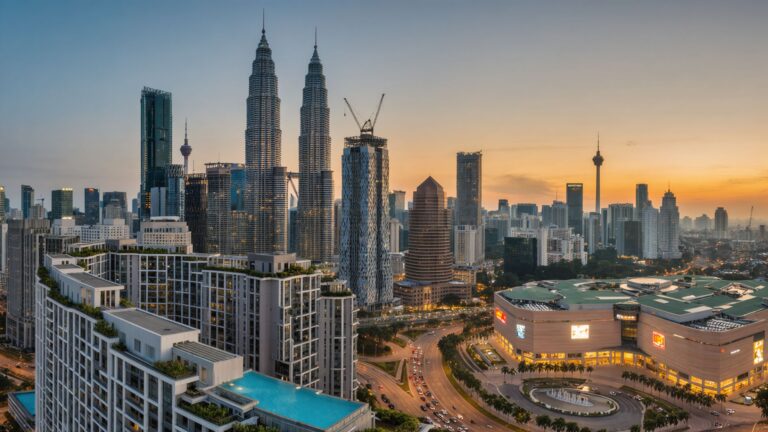Something subtle just happened in the Klang Valley housing market.
It didn’t make headlines.
No press release.
No developer roadmap.
But if you read between the lines of the Q1 2025 property stats, you’ll see a bigger story unfolding:
The market is splitting into two classes of investors—those who adapt early, and those who get stuck holding unsellable concrete.
Let’s break it down.
Kuala Lumpur Is Getting More Expensive—But Less Popular
According to the latest numbers, total property transactions in KL have dropped. But the value of those transactions went up.
Fewer people are buying—but those who are, are paying more.
This is what insiders call a luxury spiral. It’s a sign that the average buyer in KL is now someone wealthier, more insulated, and not chasing volume. They’re cherry-picking premium units, flipping for quick gains, or parking wealth.
Meanwhile, a graveyard of unsold units keeps piling up.
Over 8,400 unsold homes in KL. Mostly high-rise service apartments. Nearly 30% of them priced above RM1 million.
Developers keep building them anyway.
There are 97,000+ units in the pipeline for 2025–2027. Most of them high-rises. Yet absorption—how quickly the market swallows new stock—is slowing to a crawl.
This is what a soft collapse looks like.
Not dramatic. Just slow, relentless stagnation.
Selangor: The Quiet Comeback Kid
Now contrast that with Selangor.
Developers there are moving differently.
Less ego. More action.
Despite lower total sales, the state reduced its unsold stock by 17.5%—largely through developer discounts, flexible financing, and early-buyer incentives.
In other words, they’re clearing the board while KL players pretend nothing’s wrong.
This means Selangor investors are sitting on leaner, more liquid portfolios. They’re not stuck in million-ringgit skyboxes waiting for the next foreign buyer wave.
They’re moving forward, not holding bags.
So Where’s the Smart Money Going?
Let’s look at where prices and yields are quietly bubbling:
- Mont’Kiara still shows growth, with better rental returns than KLCC.
- Bangsar & KLCC remain desirable—but they’re yield-thin. Flipping works, long-term renting doesn’t.
- Petaling Jaya, Subang Jaya, Shah Alam and Bandar Sunway posted 4–6% annual price jumps, with yields approaching 5%.
These aren’t eye-popping numbers. But in a deflating market, stability is the new alpha.
If you’re a long-term investor looking for cash flow instead of capital gains, these pockets are your safe zones.
Also, quietly heating up: Cyberjaya.
MRCB just bought over 36 acres of land there for RM288 million. That’s not a casual flip. That’s an institutional bet on future growth—likely fueled by upcoming infrastructure, decentralization, and digital services expansion.
The KL Oversupply Reset Is Coming—And It’ll Be Violent
This is where it gets interesting.
The sheer number of unsold units in Kuala Lumpur—especially service apartments—is unsustainable.
Eventually, developers will break.
Once holding costs exceed the hope of profit, they’ll slash prices. Fire-sale deals. Full-floor discounts. Bulk purchases for overseas buyers.
This won’t be marketed. It’ll be whispered.
The real ones will know.
If you’re holding cash or have access to financing, this is your moment to prepare.
Shortlist developers with unsold stock at 80–90% construction progress.
Watch units that haven’t cleared close to CCC issuance (Certificate of Completion and Compliance).
That’s when desperation peaks.
If you strike early, you can pick up RM1 million units for RM650k, sometimes less.
Flip. Or hold and rent. Either way, you’re not the one stuck holding a pre-bubble valuation.
Final Signal: Land Is King Again
Gamuda just bought 330 acres in Selangor. That’s not for a quick townhouse project. That’s for a future township.
Translation: the real money is rotating out of KL towers and back into land.
Not for yield.
Not even for prestige.
But for long-game security.
Because the future of Malaysian housing isn’t vertical. It’s horizontal, breathable, and decentralised.
As remote work becomes permanent, as digital nomads choose Cyberjaya over KLCC, and as families get priced out of high-rise living…
Landed homes, integrated suburbs, and second-tier cities will rise.
Conclusion
This isn’t a crash.
It’s a reshuffle.
And the winners won’t be those with the tallest views.
They’ll be the ones with liquidity, timing, and the courage to leave the old map behind.
KL is bloated.
Selangor is lean.
The ground is shifting.
Now you decide: are you holding what’s next, or what’s already lost?
